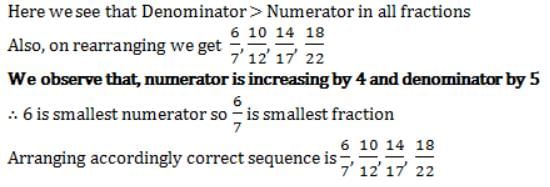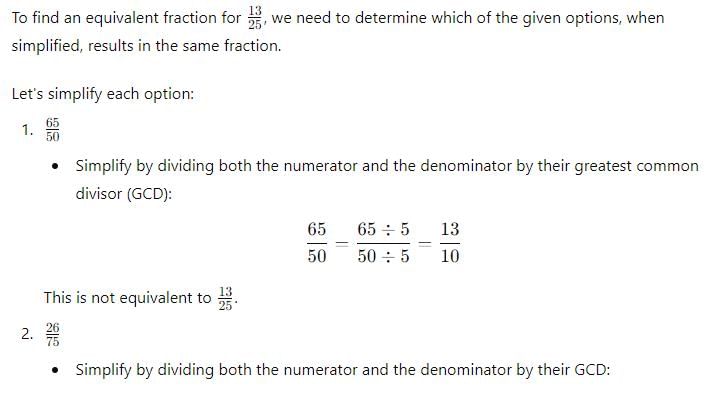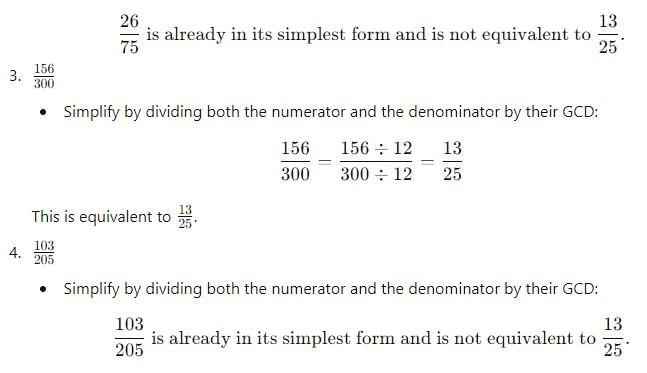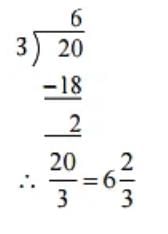All Exams >
Primary 6 >
Preparation for NCEE >
All Questions
All questions of Fractions for Primary 6 Exam
What is the fraction of the shaded area?

- a)1/8
- b)1/4
- c)1/3
- d)None of these
Correct answer is option 'A'. Can you explain this answer?
What is the fraction of the shaded area?


a)
1/8
b)
1/4
c)
1/3
d)
None of these

|
Learning Education answered |
Blocks shaded = 1
Total Blocks = 8
Hence fraction of shaded region = 1/8
What fraction of these circles have X's in them?

- a)1/3
- b)1/2
- c)1/4
- d)None of these
Correct answer is option 'B'. Can you explain this answer?
What fraction of these circles have X's in them?

a)
1/3
b)
1/2
c)
1/4
d)
None of these

|
Saimon Verma answered |
B) 1/2 is correct because there are 8 whole circles so it will be denominator and 4 circles has x in them so it will be numerator (4/8) and the simplest fraction is 1/2
Can you explain the answer of this question below:
- A:
5/7
- B:
4/7
- C:
2/7
- D:
None of these
The answer is B.
5/7
4/7
2/7
None of these
|
|
Eduskill Classes answered |
Blocks shaded = 4
Total Blocks = 7
Hence fraction of shaded region = 4/7
What fraction of an hour is 40 minutes?- a)1
- b)1/3
- c)2/3
- d)None of these
Correct answer is option 'C'. Can you explain this answer?
What fraction of an hour is 40 minutes?
a)
1
b)
1/3
c)
2/3
d)
None of these

|
Gayatri Chavan answered |
Since, 1 hour = 60minutes.
Therefore, the fraction of 40 minutes = 40/60=2/3
The simplest form of 16/72 is ________
- a)2/9
- b)1/4
- c)1/2
- d)None of these
Correct answer is option 'A'. Can you explain this answer?
The simplest form of 16/72 is ________
a)
2/9
b)
1/4
c)
1/2
d)
None of these
|
|
Prajnaloka Saha answered |
We will bring 16/72 in its simplest form by finding their common factor
16 is in 2 table and 72 is also in the table of two.
We will divide both of the digits by two.
= 8/36
Now we can also reduce these digits so let's divide these two by 2 again.
= 4/18
Simplify it again.
= 2/9
Thus option 'A' is correct
16 is in 2 table and 72 is also in the table of two.
We will divide both of the digits by two.
= 8/36
Now we can also reduce these digits so let's divide these two by 2 again.
= 4/18
Simplify it again.
= 2/9
Thus option 'A' is correct
A __________ is a number representing part of a whole.- a)decimal
- b)proper fraction
- c)fraction
- d)None of these
Correct answer is option 'C'. Can you explain this answer?
A __________ is a number representing part of a whole.
a)
decimal
b)
proper fraction
c)
fraction
d)
None of these
|
|
Ananya Das answered |
A fraction is a number representing a part of a whole. The whole may be a single object or a group of objects.
Consider the fraction 7/12. This fraction is read as ”seven-twelfth” which means that 7 parts out of 12 equal parts in which the whole is divided. In the fraction 7/12, 7 is called the numerator and 12 is called the denominator.
What is the fraction of the shaded area?

- a)1/4
- b)1/3
- c)7/8
- d)None of these
Correct answer is option 'C'. Can you explain this answer?
What is the fraction of the shaded area?

a)
1/4
b)
1/3
c)
7/8
d)
None of these
|
|
Ishan Choudhury answered |
Blocks shaded = 7
Total Blocks = 8
Hence fraction of shaded region = 7/8
Write the natural numbers from 102 to 113. What fraction of them are prime numbers?
- a)1/3
- b)1/2
- c)1/4
- d)None of these
Correct answer is option 'A'. Can you explain this answer?
Write the natural numbers from 102 to 113. What fraction of them are prime numbers?
a)
1/3
b)
1/2
c)
1/4
d)
None of these

|
Arjun Desai answered |
Natural numbers from 102 to 113: 102, 103, 104, 105, 106, 107, 108, 109, 110, 111, 112, 113
Prime numbers from 102 to 113: 103, 107, 109, 113
Hence fraction of prime numbers = 4/12 = 1/3.
Prime numbers from 102 to 113: 103, 107, 109, 113
Hence fraction of prime numbers = 4/12 = 1/3.
How is the fractional number for "3 out of 7 of the fruits are apples" written?- a)3/7
- b)7/3
- c)4/7
- d)4/3
Correct answer is option 'A'. Can you explain this answer?
How is the fractional number for "3 out of 7 of the fruits are apples" written?
a)
3/7
b)
7/3
c)
4/7
d)
4/3
|
|
Himangshu Das answered |
3 out of 7 = 3/7 is the correct answer. Therefore option A is the correct answer...
Give a proper fraction whose denominator is 7 and numerator is 5
- a)1/8
- b)7/5
- c)5/7
- d)None of these
Correct answer is option 'C'. Can you explain this answer?
Give a proper fraction whose denominator is 7 and numerator is 5
a)
1/8
b)
7/5
c)
5/7
d)
None of these

|
Dr Manju Sen answered |
The correct answer is option 'c' (5/7).
In semiconductors, at the room temperature- a)valence band is completely filled
- b)conduction band is completely empty
- c)valance band is partially empty and conduction band is partially filled
- d)valence band is completely filled and conduction band is partially filled
Correct answer is option 'C'. Can you explain this answer?
In semiconductors, at the room temperature
a)
valence band is completely filled
b)
conduction band is completely empty
c)
valance band is partially empty and conduction band is partially filled
d)
valence band is completely filled and conduction band is partially filled
|
|
Disha Khanna answered |
Explanation:
Semiconductors are materials that have a conductivity between conductors (metals) and insulators (non-metals). The conductivity of a semiconductor can be controlled by adding impurities or doping. At the room temperature, the following conditions hold true for semiconductors:
Valence Band:
- The valence band is the highest energy band that is completely filled with electrons.
- The valence band consists of the valence electrons that are tightly bound to the atoms.
- At room temperature, the valence band is partially filled with electrons, but it is not completely filled.
Conduction Band:
- The conduction band is the lowest energy band that is partially filled with electrons.
- The conduction band consists of the free electrons that are not bound to any particular atom and can move freely through the material.
- At room temperature, the conduction band is partially filled with electrons, but it is not completely empty.
Energy Gap:
- The energy gap or band gap is the energy difference between the valence band and the conduction band.
- In insulators, the energy gap is very large, and no electrons can move from the valence band to the conduction band.
- In conductors, the energy gap is zero, and the valence and conduction bands overlap.
- In semiconductors, the energy gap is small, and electrons can move from the valence band to the conduction band by absorbing energy.
Conclusion:
At room temperature, semiconductors have a partially filled valence band and a partially filled conduction band. This allows them to conduct electricity, but the conductivity can be controlled by adding impurities or doping.
Semiconductors are materials that have a conductivity between conductors (metals) and insulators (non-metals). The conductivity of a semiconductor can be controlled by adding impurities or doping. At the room temperature, the following conditions hold true for semiconductors:
Valence Band:
- The valence band is the highest energy band that is completely filled with electrons.
- The valence band consists of the valence electrons that are tightly bound to the atoms.
- At room temperature, the valence band is partially filled with electrons, but it is not completely filled.
Conduction Band:
- The conduction band is the lowest energy band that is partially filled with electrons.
- The conduction band consists of the free electrons that are not bound to any particular atom and can move freely through the material.
- At room temperature, the conduction band is partially filled with electrons, but it is not completely empty.
Energy Gap:
- The energy gap or band gap is the energy difference between the valence band and the conduction band.
- In insulators, the energy gap is very large, and no electrons can move from the valence band to the conduction band.
- In conductors, the energy gap is zero, and the valence and conduction bands overlap.
- In semiconductors, the energy gap is small, and electrons can move from the valence band to the conduction band by absorbing energy.
Conclusion:
At room temperature, semiconductors have a partially filled valence band and a partially filled conduction band. This allows them to conduct electricity, but the conductivity can be controlled by adding impurities or doping.
What is the fraction of the shaded area?

- a)1/4
- b)1/3
- c)1/2
- d)None of these
Correct answer is option 'C'. Can you explain this answer?
What is the fraction of the shaded area?

a)
1/4
b)
1/3
c)
1/2
d)
None of these

|
Pioneer Academy answered |
The fraction of shaded region is equal to the number of shaded parts divided by the number of total parts that are present in the diagram.
In the fig.
Total no. of parts = 8
No. of shaded parts = 4
Fraction of shaded region = 4/8 = 1/2.
In the fig.
Total no. of parts = 8
No. of shaded parts = 4
Fraction of shaded region = 4/8 = 1/2.
In a proper fraction the ___________ shows the number of parts which have been considered.
- a)notion
- b)numerator
- c)denominator
- d)None of these
Correct answer is option 'B'. Can you explain this answer?
In a proper fraction the ___________ shows the number of parts which have been considered.
a)
notion
b)
numerator
c)
denominator
d)
None of these
|
|
V. lihitha reddy answered |
DENOMINATOR
because in proper fraction the denominators are big than the numerators.
because in proper fraction the denominators are big than the numerators.
Write the fraction representing the shaded region in the below figure.
- a)2/7
- b)5/7
- c)4/7
- d)none of these
Correct answer is option 'B'. Can you explain this answer?
Write the fraction representing the shaded region in the below figure.

a)
2/7
b)
5/7
c)
4/7
d)
none of these

|
Nclex Coaching Centre answered |
shaded boxes : 5
unshaded boxes :2
total boxes : 7
fraction of shaded box = 5/7
What is the mixed fraction form of 41/12
- a)

- b)

- c)

- d)

Correct answer is option 'C'. Can you explain this answer?
What is the mixed fraction form of 41/12
a)

b)

c)

d)


|
Naina Iyer answered |
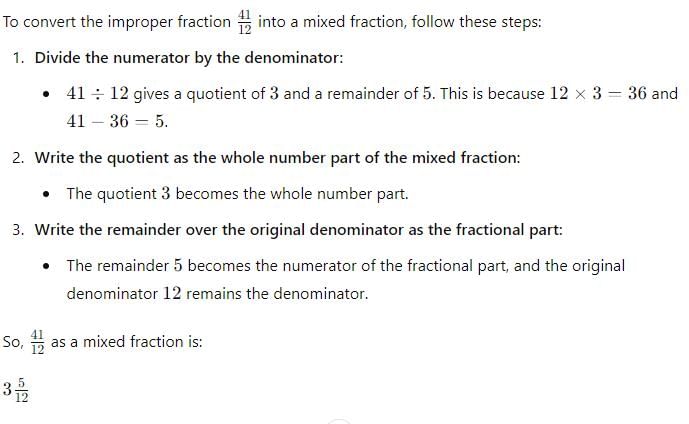
Explanation:
- Quotient: The integer part of the division, which is 333, represents how many whole parts of the denominator fit into the numerator.
- Remainder: The leftover part after dividing, which is 555, represents the part of the fraction that does not fit into a whole number.
- Denominator: The original denominator 121212 remains unchanged for the fractional part.

What is the fractional form of five eighteenths?- a)15/18
- b)18/5
- c)5.18
- d)5/18
Correct answer is option 'D'. Can you explain this answer?
What is the fractional form of five eighteenths?
a)
15/18
b)
18/5
c)
5.18
d)
5/18

|
Raj Mukherjee answered |
The fractional form of five eighteenths
= 5/18
What type of fraction is the sum 3/4 + 2/4?- a)Proper fraction
- b)Improper fraction
- c)Mixed fraction
- d)Unit fraction
Correct answer is option 'B'. Can you explain this answer?
What type of fraction is the sum 3/4 + 2/4?
a)
Proper fraction
b)
Improper fraction
c)
Mixed fraction
d)
Unit fraction

|
Yashvi Choudhary answered |
3/4 + 2/4 = 3+2/4 = 5/4 is an improper fraction. Since, the numerator is greater than the denominator.
Shabana has to stitch 35 dresses. So, ar she has stitched 21 dresses. What fraction of dresses has she stitched?- a)7/9
- b)3/5
- c)6/5
- d)3/7
Correct answer is option 'B'. Can you explain this answer?
Shabana has to stitch 35 dresses. So, ar she has stitched 21 dresses. What fraction of dresses has she stitched?
a)
7/9
b)
3/5
c)
6/5
d)
3/7

|
EduRev Class 6 answered |
Shabana has stitched 21 dresses out of a total of 35 dresses. The fraction of dresses she has stitched is 21/35.
To simplify, divide both the numerator (21) and denominator (35) by their HCF, which is 7:

So, the correct fraction of dresses she has stitched is 3/5.

So, the correct fraction of dresses she has stitched is 3/5.
Give an example for a proper fraction.- a)28/13
- b)11/23
- c)16/9
- d)14/3
Correct answer is option 'B'. Can you explain this answer?
Give an example for a proper fraction.
a)
28/13
b)
11/23
c)
16/9
d)
14/3

|
Subham Rane answered |
In a proper fraction, the numerator is less than the denominator.
By how much is 19/20 greater than 2/20?- a)21/20
- b)21/40
- c)17/20
- d)17/40
Correct answer is option 'C'. Can you explain this answer?
By how much is 19/20 greater than 2/20?
a)
21/20
b)
21/40
c)
17/20
d)
17/40

|
Shounak Joshi answered |
19/20 - 2/20 = 19 - 2/20 = 17/20
What should be added to 11/17 to make it 15/17?- a)26/17
- b)4
- c)4/17
- d)4/34
Correct answer is option 'C'. Can you explain this answer?
What should be added to 11/17 to make it 15/17?
a)
26/17
b)
4
c)
4/17
d)
4/34

|
Dr Manju Sen answered |
To find what should be added to 11/17 to make it 15/17, subtract 11/17 from 15/17:
15/17 - 11/17 = (15 - 11)/17 = 4/17
Thus, the number to be added is 4/17.
Two fractions are equivalent if their cross multiplications are- a)0.
- b)1.
- c)equal.
- d)not equal.
Correct answer is option 'C'. Can you explain this answer?
Two fractions are equivalent if their cross multiplications are
a)
0.
b)
1.
c)
equal.
d)
not equal.

|
Harshitha Mukherjee answered |
Two fractions are equivalent if they have the same value. The numbers may be different, but the overall value is the same. For example, 1/2 and 2/4 are equivalent fractions because they both represent one-half of something. To determine if two fractions are equivalent, cross multiply. To cross multiply, you multiple the numerator of the first fraction by the denominator of the second. Then you multiply the denominator of the first fraction by the numerator of the second. If the two numbers are equal, the fractions are equivalent. In this example 1 X 4 = 4 and 2 X 2 = 4. The fractions are therefore equivalent.
The identity (x+3)(x+4) = x² + 7x + 12 is true for- a)two values of x
- b)one value of x
- c)all value of x
- d)None of Above
Correct answer is option 'C'. Can you explain this answer?
The identity (x+3)(x+4) = x² + 7x + 12 is true for
a)
two values of x
b)
one value of x
c)
all value of x
d)
None of Above

|
Vishal Giri answered |
L. H. S. =(X +3)(X +4) = ( X ^2 +4X + 3X + 12) = X^2 + 7X + 12 = R. H. S. L. H. S =R. H. S. here u can take any value of X it will same that L. h. s = R. h. s.
The sum of 5/6 + 1/3 is _____.- a)7/6
- b)2/3
- c)1
- d)None of these
Correct answer is option 'A'. Can you explain this answer?
The sum of 5/6 + 1/3 is _____.
a)
7/6
b)
2/3
c)
1
d)
None of these
|
|
Harshad Goyal answered |
Understanding the Problem
To find the sum of the fractions 5/6 and 1/3, we first need to ensure that both fractions have a common denominator.
Finding the Common Denominator
- The denominators are 6 and 3.
- The least common multiple (LCM) of 6 and 3 is 6.
Converting the Fractions
- The first fraction, 5/6, already has the denominator of 6.
- The second fraction, 1/3, needs to be converted:
- Multiply both the numerator and denominator by 2:
- 1 * 2 = 2
- 3 * 2 = 6
- So, 1/3 becomes 2/6.
Adding the Fractions
Now we can add the two fractions:
- 5/6 + 2/6
- Since the denominators are the same, we add the numerators:
- 5 + 2 = 7
- The sum is 7/6.
Final Answer
Thus, the sum of 5/6 + 1/3 is 7/6, which corresponds to option 'A'.
This method of finding a common denominator and adding fractions is fundamental in fraction operations, making it essential for class 6 mathematics.
To find the sum of the fractions 5/6 and 1/3, we first need to ensure that both fractions have a common denominator.
Finding the Common Denominator
- The denominators are 6 and 3.
- The least common multiple (LCM) of 6 and 3 is 6.
Converting the Fractions
- The first fraction, 5/6, already has the denominator of 6.
- The second fraction, 1/3, needs to be converted:
- Multiply both the numerator and denominator by 2:
- 1 * 2 = 2
- 3 * 2 = 6
- So, 1/3 becomes 2/6.
Adding the Fractions
Now we can add the two fractions:
- 5/6 + 2/6
- Since the denominators are the same, we add the numerators:
- 5 + 2 = 7
- The sum is 7/6.
Final Answer
Thus, the sum of 5/6 + 1/3 is 7/6, which corresponds to option 'A'.
This method of finding a common denominator and adding fractions is fundamental in fraction operations, making it essential for class 6 mathematics.
Write the fraction representing the shaded portion.
- a)5/9
- b)4/9
- c)8/9
- d)7/9
Correct answer is option 'C'. Can you explain this answer?
Write the fraction representing the shaded portion.

a)
5/9
b)
4/9
c)
8/9
d)
7/9

|
Siva Prasad answered |
8/9 is correct answer
8 boxes are shaded by 9 boxes
8 boxes are shaded by 9 boxes
Which of the following fractions is the largest?- a)29/30
- b)29/23
- c)29/27
- d)29/25
Correct answer is option 'B'. Can you explain this answer?
Which of the following fractions is the largest?
a)
29/30
b)
29/23
c)
29/27
d)
29/25

|
Ameya Choudhury answered |
All fractions have the same numerator. So, the fraction having the smallest denominator is the largest.
∴ 29/23 is the required largest fraction.
Raju scored 9 marks in maths test. If the maximum marks of the test is 25, how is Raju's score represented as a fraction?- a)1/25
- b)16/25
- c)9/25
- d)25/25
Correct answer is option 'C'. Can you explain this answer?
Raju scored 9 marks in maths test. If the maximum marks of the test is 25, how is Raju's score represented as a fraction?
a)
1/25
b)
16/25
c)
9/25
d)
25/25

|
Yashvi Choudhary answered |
Maximum marks = 25 Marks scored by Raju = 9
∴ Raju's score represented as a fraction
= 9/25
What is the simplified form of the product 12/24 and 36/72- a)16/24
- b)3/5
- c)4
- d)1/4
Correct answer is option 'D'. Can you explain this answer?
What is the simplified form of the product 12/24 and 36/72
a)
16/24
b)
3/5
c)
4
d)
1/4

|
Isha Basak answered |
12/24 x 36/72 = 1/2 x 1/2 = 1/4
To reduce a rational number to its standard form, we divide its numerator and denominator by their- a)LCM
- b)HCF
- c)product
- d)multiple
Correct answer is option 'B'. Can you explain this answer?
To reduce a rational number to its standard form, we divide its numerator and denominator by their
a)
LCM
b)
HCF
c)
product
d)
multiple
|
|
Sanskriti Bose answered |
Understanding Rational Numbers
A rational number is expressed as a fraction, where the numerator and denominator are integers. To reduce a rational number to its standard form, we need to simplify this fraction.
Why Use HCF for Simplification?
When simplifying a fraction, our goal is to find the simplest form where the numerator and denominator have no common factors other than 1. This is where the HCF (Highest Common Factor) comes into play.
Steps to Reduce a Rational Number:
- Identify the numerator and the denominator of the fraction.
- Find the HCF of the numerator and denominator.
- Divide both the numerator and the denominator by this HCF.
Example:
Consider the fraction 8/12.
- The HCF of 8 and 12 is 4.
- Dividing both by 4 gives us 2/3.
Now, 2/3 is in its simplest form.
Why Not Use Other Options?
- LCM (Least Common Multiple): This is used for finding common denominators, not for simplification.
- Product: Dividing by the product would not yield a reduced fraction but rather complicate it.
- Multiple: Using a multiple could lead to larger numbers, not a simplified form.
Conclusion
Reducing a rational number to its standard form efficiently requires dividing by the HCF. This ensures that the fraction is expressed in its simplest terms, making it easier to work with in mathematical operations.
A rational number is expressed as a fraction, where the numerator and denominator are integers. To reduce a rational number to its standard form, we need to simplify this fraction.
Why Use HCF for Simplification?
When simplifying a fraction, our goal is to find the simplest form where the numerator and denominator have no common factors other than 1. This is where the HCF (Highest Common Factor) comes into play.
Steps to Reduce a Rational Number:
- Identify the numerator and the denominator of the fraction.
- Find the HCF of the numerator and denominator.
- Divide both the numerator and the denominator by this HCF.
Example:
Consider the fraction 8/12.
- The HCF of 8 and 12 is 4.
- Dividing both by 4 gives us 2/3.
Now, 2/3 is in its simplest form.
Why Not Use Other Options?
- LCM (Least Common Multiple): This is used for finding common denominators, not for simplification.
- Product: Dividing by the product would not yield a reduced fraction but rather complicate it.
- Multiple: Using a multiple could lead to larger numbers, not a simplified form.
Conclusion
Reducing a rational number to its standard form efficiently requires dividing by the HCF. This ensures that the fraction is expressed in its simplest terms, making it easier to work with in mathematical operations.
Which of the following is not in the lowest form?- a)7/5
- b)15/20
- c)13/33
- d)27/28
Correct answer is option 'B'. Can you explain this answer?
Which of the following is not in the lowest form?
a)
7/5
b)
15/20
c)
13/33
d)
27/28
|
|
Sagnik Saha answered |
Understanding Lowest Terms
To determine whether a fraction is in its lowest form, we need to check if the numerator and denominator share any common factors other than 1. A fraction is in its lowest terms if the greatest common divisor (GCD) of the numerator and denominator is 1.
Analyzing Each Option
- Option A: 7/5
- Numerator: 7
- Denominator: 5
- Common Factors: 1
- Conclusion: This fraction is in lowest terms.
- Option B: 15/20
- Numerator: 15
- Denominator: 20
- Common Factors: Both 15 and 20 can be divided by 5.
- Simplification: 15 ÷ 5 = 3, 20 ÷ 5 = 4
- Simplified Fraction: 3/4
- Conclusion: This fraction is NOT in lowest terms.
- Option C: 13/33
- Numerator: 13
- Denominator: 33
- Common Factors: 1 (13 is a prime number and does not divide 33)
- Conclusion: This fraction is in lowest terms.
- Option D: 27/28
- Numerator: 27
- Denominator: 28
- Common Factors: 1 (no common factors)
- Conclusion: This fraction is in lowest terms.
Final Conclusion
After analyzing all options, it is clear that Option B (15/20) is not in the lowest form as it can be simplified to 3/4. All other options are in their lowest terms.
To determine whether a fraction is in its lowest form, we need to check if the numerator and denominator share any common factors other than 1. A fraction is in its lowest terms if the greatest common divisor (GCD) of the numerator and denominator is 1.
Analyzing Each Option
- Option A: 7/5
- Numerator: 7
- Denominator: 5
- Common Factors: 1
- Conclusion: This fraction is in lowest terms.
- Option B: 15/20
- Numerator: 15
- Denominator: 20
- Common Factors: Both 15 and 20 can be divided by 5.
- Simplification: 15 ÷ 5 = 3, 20 ÷ 5 = 4
- Simplified Fraction: 3/4
- Conclusion: This fraction is NOT in lowest terms.
- Option C: 13/33
- Numerator: 13
- Denominator: 33
- Common Factors: 1 (13 is a prime number and does not divide 33)
- Conclusion: This fraction is in lowest terms.
- Option D: 27/28
- Numerator: 27
- Denominator: 28
- Common Factors: 1 (no common factors)
- Conclusion: This fraction is in lowest terms.
Final Conclusion
After analyzing all options, it is clear that Option B (15/20) is not in the lowest form as it can be simplified to 3/4. All other options are in their lowest terms.
Fill appropriate sign (>,<, or = )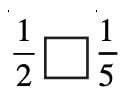
- a)>
- b)<
- c)=
- d)None of the above
Correct answer is option 'A'. Can you explain this answer?
Fill appropriate sign (>,<, or = )

a)
>
b)
<
c)
=
d)
None of the above

|
Praveen Kumar answered |
Here, the numerators are the same. So, the fraction having a lesser denominator is greater ∴ 1 / 2 > 1 / 5
The identity (x+3)(x+4) = x² + 7x + 12 is true for- a)two values of x
- b)one value of x
- c)all value of x
- d)None of Above
Correct answer is 'C'. Can you explain this answer?
The identity (x+3)(x+4) = x² + 7x + 12 is true for
a)
two values of x
b)
one value of x
c)
all value of x
d)
None of Above

|
Abhijeet Choudhary answered |
We are looking for factors of 12 which ADD (becaus... moree of + 12) up to 7.The signs will be the same (because of + 12), they are both negative (because of -7).The
Express  mixed fractions as improper fractions
mixed fractions as improper fractions- a)65/9
- b)64/9
- c)16/9
- d)19/9
Correct answer is option 'B'. Can you explain this answer?
Express  mixed fractions as improper fractions
mixed fractions as improper fractions
 mixed fractions as improper fractions
mixed fractions as improper fractionsa)
65/9
b)
64/9
c)
16/9
d)
19/9

|
Shweta Singhal answered |
Multiply 9 by 7 then add 1 =64 Let 9 remain the denominator Answer= 64\9
Fractions with same denominators are called ________.- a)unlike fractions
- b)like fractions
- c)mixed fractions
- d)None of these
Correct answer is option 'B'. Can you explain this answer?
Fractions with same denominators are called ________.
a)
unlike fractions
b)
like fractions
c)
mixed fractions
d)
None of these
|
|
Prasad Kulkarni answered |
Like Fractions: The fractions having the same denominators are known as like fractions. We know that fractions such as 2/5, 3/5, 5/5, 7/5, 9/5, …. etc., are like fractions.
What is the fraction of the shaded area?
- a)1/3
- b)4/6
- c)1/4
- d)1/2
Correct answer is option 'B'. Can you explain this answer?
What is the fraction of the shaded area?

a)
1/3
b)
4/6
c)
1/4
d)
1/2

|
Praveen Kumar answered |
Blocks shaded = 4
Total Blocks = 6
Hence fraction of shaded region = 4/6
Total Blocks = 6
Hence fraction of shaded region = 4/6
How is the fractional number for "3 out of 7 of the fruits are apples" written?- a)3/7
- b)7/3
- c)4/7
- d)4/3
Correct answer is option 'A'. Can you explain this answer?
How is the fractional number for "3 out of 7 of the fruits are apples" written?
a)
3/7
b)
7/3
c)
4/7
d)
4/3

|
Coachify answered |
"3 out of 7" means that out of a total of 7 fruits, 3 are apples. The fraction is written as 3/7, where:
- Numerator (3): Number of apples
- Denominator (7): Total number of fruits
What is the simplest form of 15/75?- a)1/2
- b) 1/4
- c) 1/5
- d)None of these
Correct answer is option 'C'. Can you explain this answer?
What is the simplest form of 15/75?
a)
1/2
b)
1/4
c)
1/5
d)
None of these

|
Praveen Kumar answered |
To simplify 15/75, divide both the numerator and denominator by their greatest common divisor (GCD), which is 15.
15 ÷ 15 = 1, 75 ÷ 15 = 5
The simplest form is 1/5.
What are the fractions with the same denominator called?- a)Unit fractions
- b)Unlike fractions
- c)Like fractions
- d)Improper fractions
Correct answer is option 'C'. Can you explain this answer?
What are the fractions with the same denominator called?
a)
Unit fractions
b)
Unlike fractions
c)
Like fractions
d)
Improper fractions

|
Shiksha Academy answered |
Fractions with the same denominator are called like fractions. For example:
- Examples of like fractions: 2/7, 5/7, 9/7
- Unlike fractions have different denominators: 1/4, 3/8, 5/6
- Unit fractions have numerator as 1: 1/2, 1/3, 1/4
- Improper fractions have numerator greater than or equal to the denominator: 7/5, 9/4
The mixed fraction  can be expressed as
can be expressed as - a)33/7
- b)39/7
- c)33/4
- d)39/4
Correct answer is option 'B'. Can you explain this answer?
The mixed fraction  can be expressed as
can be expressed as
 can be expressed as
can be expressed as a)
33/7
b)
39/7
c)
33/4
d)
39/4

|
Shiksha Academy answered |
To convert the mixed fraction  into an improper fraction:
into an improper fraction:
 into an improper fraction:
into an improper fraction:- Multiply the whole number (5) by the denominator (7): 5 × 7 = 35
- Add the numerator of the fraction (4) to the result: 35 + 4 = 39
- The improper fraction is 39/7.
Thus,  can be expressed as 39/7.
can be expressed as 39/7.
 can be expressed as 39/7.
can be expressed as 39/7.Which of the following is an improper fraction?- a)7/10
- b)7/9
- c)9/7
- d)none of these
Correct answer is option 'C'. Can you explain this answer?
Which of the following is an improper fraction?
a)
7/10
b)
7/9
c)
9/7
d)
none of these

|
Dr Manju Sen answered |
An improper fraction is one where the numerator is greater than or equal to the denominator.
- 7/10 and 7/9 are proper fractions because the numerator is smaller than the denominator.
- 9/7 is an improper fraction because the numerator (9) is greater than the denominator (7).
Chapter doubts & questions for Fractions - Preparation for NCEE 2025 is part of Primary 6 exam preparation. The chapters have been prepared according to the Primary 6 exam syllabus. The Chapter doubts & questions, notes, tests & MCQs are made for Primary 6 2025 Exam. Find important definitions, questions, notes, meanings, examples, exercises, MCQs and online tests here.
Chapter doubts & questions of Fractions - Preparation for NCEE in English & Hindi are available as part of Primary 6 exam.
Download more important topics, notes, lectures and mock test series for Primary 6 Exam by signing up for free.
Preparation for NCEE
255 videos|742 docs|140 tests
|

Contact Support
Our team is online on weekdays between 10 AM - 7 PM
Typical reply within 3 hours
|
Free Exam Preparation
at your Fingertips!
Access Free Study Material - Test Series, Structured Courses, Free Videos & Study Notes and Prepare for Your Exam With Ease

 Join the 10M+ students on EduRev
Join the 10M+ students on EduRev
|

|
Create your account for free
OR
Forgot Password
OR
Signup to see your scores
go up
within 7 days!
within 7 days!
Takes less than 10 seconds to signup

